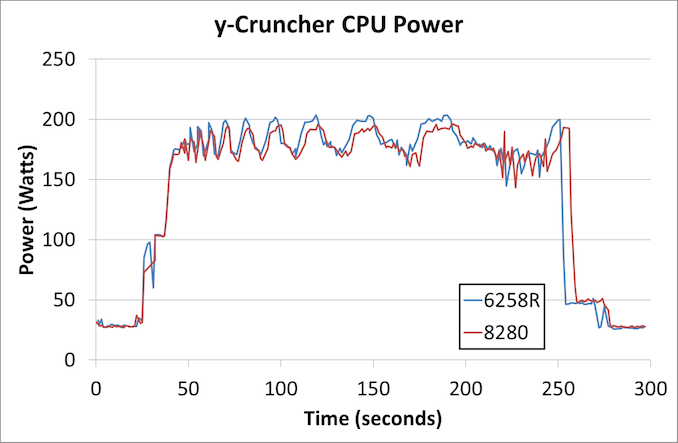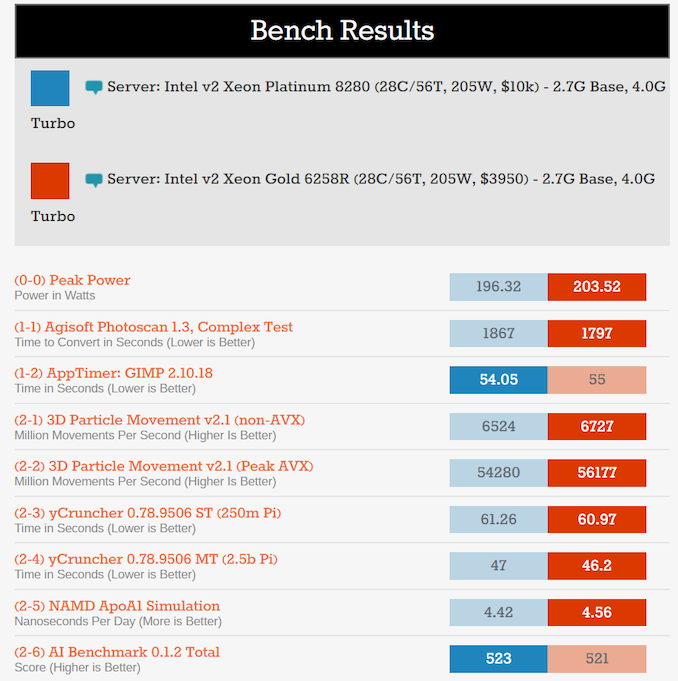How to Save $6000 on a 28-core Flagship Intel Xeon: Platinum 8280 vs Gold 6258R
by Dr. Ian Cutress on August 7, 2020 8:00 AM ESTTest Bed and Benchmarks
For this test, we’ve run through our updated suite of benchmarks, as part of our #CPUOverload project. As this isn’t a strict review of the processors, more of a comparison article to see if they perform the same, then each benchmark is relatively binary– yes it performs the same, or no they don’t (and which one is better). For these tests, we fired up our single socket LGA3647 testbed.
| AnandTech LGA3647 Test Bed | |||||
| AnandTech | COLUMN | ||||
| CPU | Intel Xeon Platinum 8280 Intel Xeon Gold 6258R |
28C/56T 28C/56T |
2.7-4.0G 2.7-4.0G |
205W 205W |
$10009 $3950 |
| Cooling | Asetek 690LX-PN (500W) | ||||
| Motherboard | ASUS ROG Dominus Extreme (0601) | ||||
| DRAM | SKHynix 6 x 32 GB DDR4-2933 | ||||
| SSD | Crucial MX500 1TB | ||||
| PSU | EVGA 1600T2 | ||||
| GPU | Sapphire RX460 | ||||
| Chassis | Anidees Crystal XL | ||||
Both processors were tested on 192 GB of SK-Hynix DDR4-2933 RDIMMs, and a sufficient 500W liquid cooling configuration.
For non-performance benchmark related data, we saw both CPUs score the same average core-to-core latency (8280 was 45.8 ns, 6258R was 45.6 ns), both CPUs get to turbo from idle to max in 35-38 milliseconds, and power consumption was almost identical.
There is a slight variation here, though this could just be down to the specific voltage characteristics of the chips I have. The 6258R hits nearer the 205 W TDP that both chips have.
For the performance benchmarks, don’t get too excited all at once. We’ll mark any performance difference as significant where a >4% change is observed.
| Intel Xeon Scalable 2nd Gen Shootout | |||
| AnandTech | Platinum 8280 |
Gold 6258R |
Performance 6258R vs 8280 |
| Office | |||
| Agisoft 1.3 | 1867 sec | 1797 sec | 103.8% |
| AppTimer GIMP | 54.1 sec | 55.0 sec | 98.4% |
| Science | |||
| 3DPMavx | 54280 pts | 56177 pts | 103.5% |
| yCruncher 2.5b | 47.00 sec | 46.20 sec | 101.7% |
| NAMD ApoA1 | 4.42 ns/day | 4.56 ns/day | 103.2% |
| AIBench 0.1.2 | 523 pts | 521 pts | 99.6% |
| Simulation | |||
| DigiCortex 1.35 | 2.47x | 2.48x | 100.4% |
| DwarfFortress S | 124 sec | 124 sec | = |
| Dolphin 5.0 | 329 sec | 329 sec | = |
| Rendering | |||
| Blender 2.83 | 224 sec | 224 sec | = |
| Corona 1.3 | 13.30 Mray/sec | 13.64 Mray/sec | 102.6% |
| POV-Ray 3.7.1 | 10370 pts | 10461 pts | 100.8% |
| V-Ray | 36899 Kray/sec | 38366 Kray/sec | 103.98% |
| CB R20 ST | 391 pts | 393 pts | 100.5% |
| CB R20 MT | 11539 pts | 11851 pts | 102.7% |
| Encoding | |||
| Handbrake 1.3.2 4K | 74 fps | 74 fps | = |
| 7zip Combined | 183k MIPS | 189k MIPS | 103.2% |
| AES Encode | 15.9 GB/s | 16.4 GB/s | 103.1% |
| WinRAR 5.90 | 30.52 sec | 30.17 sec | 101.2% |
| Legacy / Web | |||
| CB10 ST | 8183 pts | 8185 pts | 100.02% |
| CB10 MT | 66851 pts | 66198 pts | 99.0% |
| Kraken | 929 ms | 929 ms | = |
| Speedometer | 90 rpm | 90 rpm | = |
| Synthetic | |||
| GB4 ST Overall | 4739 pts | 4737 pts | 99.95% |
| GB4 MT Overall | 65039 pts | 66274 pts | 101.9% |
| DRAM Read | 124 GB/s | 126 GB/s | 101.6% |
| DRAM Write | 102 GB/s | 102 GB/s | = |
| DRAM Copy | 115 GB/s | 116 GB/s | 100.9% |
| sha256 8k ST | 486 MB/s | 487 MB/s | 100.2% |
| sha256 8k MT | 12452 MB/s | 12833 MB/s | 103.1% |
| LinX 0.9.5 | 1484 GFLOPs | 1528 GFLOPs | 103.0% |
| SPEC (Geomean of tests, Estimated)* | |||
| SPEC2006 ST | 45.8 | 45.8 | = |
| SPEC2017 ST | 6.0 | 6.0 | = |
| SPEC2017 MT | 109.4 | 111.1 | 101.6% |
| *SPEC results not submitted to SPEC.org have to be labelled as 'Estimated' as per SPEC press licensing rules. | |||
Well, that was a whole lotta nothing.
If we retain that a 4% difference might be more than just statistical noise, then none of these benchmarks come close. A slightly blurry eye with these results might concede that the 6258R actually has the upper hand, which might go in line with the slight variation in power consumption we saw in the power test. But by and large, these chips are essentially identical in performance.
Breakdowns of most of the benchmarks and sub-tests can be found by looking at our benchmark comparison database, Bench. To get the best experience when comparing products on Bench. I find it best to increase the browser zoom and reduce the browser window width, so it looks like this:
Click on the image to go to the section in Bench that compares these two CPUs.












81 Comments
View All Comments
PixyMisa - Monday, August 10, 2020 - link
You're a loony.schujj07 - Friday, August 7, 2020 - link
I use both Ryzen and Epyc at my job. We have people who have the hardware assisted virtualization turned on in Win 10 for use with Virtual Box. They don't have any issues at all on the AMD hardware and those VMs run 24/7. For the Epyc server platforms, AMD Virtualization is turned on by default in the BIOS. Those VMware hosts run 24/7 with 100% uptime and not a single VM crash for months on end. Only time there is a reboot is to upgrade ESXi. They aren't just running little DNS Servers either, they are running HANA DBs, SQL DBs, Oracle DBs, etc... The VAR I use has never had anyone with the issues you are describing either.ZoZo - Friday, August 7, 2020 - link
You misunderstood. I didn't say you couldn't run virtual machines, I said you couldn't run [hardware-accelerated] virtual machines within a virtual machine running a Windows OS, aka nested virtualization.So for instance, if you have a Windows guest, you can't use the Windows Sandbox feature on it.
I'm not making that up, it's a feature planned for 20H2 :
https://techcommunity.microsoft.com/t5/virtualizat...
schujj07 - Saturday, August 8, 2020 - link
I have a couple nested ESXi hosts on hardware assisted virtualization on AMD Epycs that work just fine. Maybe don't use Hyper-V and you will be fine.ZoZo - Sunday, August 9, 2020 - link
Yes, maybe don't use this, and this, and that. That's my point. Thanks.ZoZo - Sunday, August 9, 2020 - link
Also, I think you still haven't understood what I was talking about. It's not what the host hypervisor is that matters, it's what the guest OS is that matters. Even if the host is ESXi, you won't be able to use Windows Sandbox (or any other virtualization-based software) under a Windows guest until later this year. But maybe I just stumbled upon the only software incompatibility in the whole market.WaltC - Friday, August 7, 2020 - link
Let's hope the Intel stuff does "just work" after having been milked for so long...;) It should certainly be "mature" by now, eh? And sure, I guess Linus Torvalds is a noob when it comes to CPUs, sure. What does he know?--he probably picked up AMD and rejected Intel because he enjoys all the "weird stuff that has no resolution in sight"--you betcha. BTW, Intel doesn't make anything competitive with TR--TR is a "prosumer" product. Spread that around to the very few OEMs who sell $10k Intel processors these days...;) You might want to consider getting over your childish pique concerning AMD, guy, seriously. It's rather silly. AMD is here and is Intel's worst nightmare, and that will not be changing anytime soon. All that remains to be seen is how long it will take Intel to catch up to AMD *this time*...that is, if AMD allows that to happen in the first place, imo. AMD now is firmly ensconced as a moving target architecturally--going to be an order of magnitude more difficult for Intel from now on. Pushing Intel onto a completely new architecture is just what Intel needs--maybe with a new design from the ground up like AMD's Zen architectures--because it should enable Intel to design out all the security flaws its *current* architectures have developed a sizable reputation for having! That's not something any CPU maker wants! Talk about "no resolution in sight"--the only resolution for Intel's myriad security flaws is a brand-new, ground-up architecture. Nothing else will do--right, Intel? Atta' boy--go get' um...;)Santoval - Friday, August 7, 2020 - link
"maybe with a new design from the ground up like AMD's Zen architectures"That is already on Intel's schedule and in fact it was announced right when Intel hired Jim Keller. I am referring to Ocean Cove, the apparent successor of Golden Cove (the "big" core of Alder Lake). Ostensibly the CPUs with Ocean Cove cores are going to be called Meteor Lake. It is also supposed to be Intel's first 7nm CPU (it will be fabbed either at Intel's 7nm node or -if Intel craps the bed completely- at TSMC's 4/5nm node).
I have no idea if Jim Keller's sudden departure will affect or delay the release of Ocean Cove / Meteor Lake but my guess is that it will. Therefore, on top of the 6-month delay of 7nm and the 12-month delay of high enough yields at 7nm the earliest Meteor Lake could be released is early 2024 - assuming no further delays. So it will compete against either Zen 5 or 6.
ZoZo - Friday, August 7, 2020 - link
"You might want to consider getting over your childish pique concerning AMD, guy, seriously. It's rather silly. AMD is here and is Intel's worst nightmare"That's the language of someone who's blindly cheering for his underdog team at a sports contest. There's no conversation to be had around that, it just discredits everything you might want to say.
Joe Braga - Friday, August 7, 2020 - link
The main fault in this case is Microsoft